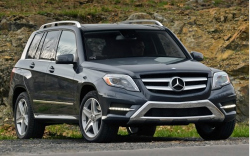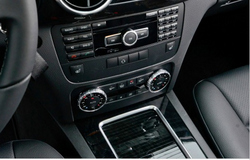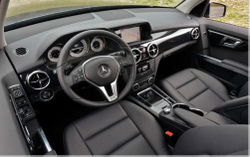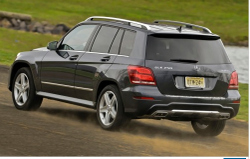Direct Injection, Diesel and Start-Stop Pump Up MPG

In response to Europe’s 2007 legislated carbon emissions reduction rules, Mercedes-Benz and other European automakers began equipping their non-hybrid vehicles with start-stop systems, a relatively low-tech, low-cost technology that moderately improves tailpipe emissions and fuel economy.
Even though the U.S. Environmental Protection Agency (EPA) doesn’t credit automakers for installing the CO2 reducing and fuel saving system feature, Mercedes has been phasing in vehicles with start-stop in its U.S. lineup since 2011. So it was no surprise when the refreshed GLK compact sport utility arrived in 2013, start-stop was standard.
In addition to start-stop, the 2013 GLK featured fresh styling, a redesigned cabin and upped its features, power and fuel economy. New for the GLK is a 2.1-liter four-cylinder turbodiesel BlueTEC model, the GLK250.
The 2014 GLK edition reprises the changes for model-year 2013 and continues with rear-wheel and all-wheel drive offerings.
Pricing for the 2014 models has increased slightly. The gasoline powered GLK350 is offered in a rear-wheel drive model with a base price of $38,405, a $420 bump over the 2013, and an all-wheel drive version starting at $40,405, also up $420. The 2014 GLK250 diesel, available only with AWD, sees a $610 increase to $39,905.
No, that isn’t a typo; the diesel is $500 less than the comparable gas-powered model.
GLK350 Start-Stop System
Like the majority of European non-hybrid vehicle start-stop systems, the GLK’s is considered a “light” start-stop.

Mercedes-Benz calls their system ECO Start/Stop, and we found it to be one of the best we have tested – hybrid or non-hybrid. Engine restart was nearly imperceptible and take off occurred without any noticeable time lag or hiccup compared to a stationary vehicle with its engine running.
Having said that, on our way to the LeMay car museum in Tacoma, WA, an accident on the interstate created what seemed like a foot-by-foot stop-and-go crawl. With the constant off-on activation, there was a shudder on start up. The solution? Hit the off button. After that, the operation was again without fault.
Those quick, smooth restarts begin with what’s called a crankshaft Hall sensor. It identifies the rotational direction of the crankshaft, enabling the engine control unit to identify the cylinder in which the piston is ideally positioned for starting. Fuel is injected into this cylinder first, thereby speeding up the starting process.
At the same time, an additional electric transmission oil pump supplies the clutches of the automatic transmission with oil pressure prior to starting. This preps the transmission for a quick take-off after the engine starts.
The starter motor has been beefed up to cope with eight times as many starting procedures and, an additional 12-volt absorbed glass matt battery supports the on-board electrical system when the engine shuts down.
Under The Hood
It could be argued that the GLK350 is a tall, boxy Mercedes C-Class sport wagon. That’s not too far off since while the GLK looks like an SUV, it borrows its platform from the C-Class cars.
That platform includes the same naturally aspirated 3.5-liter V6 engine that powers the C350 sports sedan. It’s a re-engineered version of the previous six with direct-injection technology that optimizes power and fuel efficiency.

Though still 3.5-liters, horsepower is now 302, a gain of 34, and torque is 273 pounds feet, an increase of 15.
Output from the six is channeled through a seven-speed automatic transmission to either the rear wheels or all four wheels with the $2,000 4Matic all-wheel-drive package. 4Matic is a permanent all-wheel system with a default front-rear torque split of 45/55. As traction needs dictate, 70 percent of available torque can be directed to either axle.
Even though engine power is up, government fuel economy ratings are also up – an increase of 3 mpg city and 4 mpg highway for both rear and all-wheel drive modes. Fuel economy for our 4Matic-equipped test driver is an estimated 19 city/25 highway and 21 combined.
Styling
Mercedes said the refreshed GLK has more than a thousand new parts, though you’d be hard pressed to notice at first glance. Shunning the trend of swoopy, curvy crossovers, the GLK’s unabashed two-box design proclaims that it’s a sport-utility vehicle and shares styling elements with the GL-Class full-size SUV.
Complementing the aggressive stance is a revised bold upper grille and a lower trapezoidal air intake grille with a large chrome surround. Sleek LED running lights below triangular headlights are a nod toward modernization.
A chiseled character line sweeps upward from the angled front wheel arches toward the rear. In back, new taillights with LED accents, a prominent chrome skidplate with restyled exhaust tips suggest ruggedness.
Elegant Cabin, Tech-Rich Features
Inside the GLK is where the one thousand new parts become apparent. The dash projects an elegant appearance with tasteful burl walnut trim that spans across its width.
High-quality, soft-touch interior materials, with double stitching on some of the trim, combined with superb fit and finish, endorse Mercedes-Benz’s reputation for fine craftsmanship.

The vast array of controls are perplexing at first, but a short stint with the owner’s manual brings sense to dashboard buttons, steering wheel controls and the Mercedes COMAND knob that operates audio, navigation and telephone.
A steering column gear shift lever replaces the previous center console shifter, making room for the addition of two cupholders. But their location make it difficult to operate the low mounted climate controls when a favorite Starbuck’s drink is on board.
Front bucket seats may seem a bit Germanic firm at first, but as the miles fly by, they prove to be extremely comfortable with just the right amount of support. The rear bench is also comfy. Unfortunately, the GLK is one of the smallest compact SUVs on the market, so there is really only room for two adults in the rear, and they have to contend with tight legroom.

That small size carries over to the cargo area where space is just 23.3 cubic feet behind the second row — just barely enough room to hold a week’s worth of groceries for two – as we found out. Rear seats are split 60/40 and fold forward to expand the cargo bin to 54.7 cubic feet of room, which is less than any compact competitor.
High-tech features first introduced on top-end Benzes have migrated down to the GLK; radar-controlled adaptive cruise control can bring the little SUV to a complete stop in heavy traffic, then start it moving again when traffic clears. Become drowsy or inattentive and Attention Assist will give off audible and dash warnings. And, if you haven’t mastered parallel parking, Parktronic with Active Park Assist will do it for you.
Standard on all GLKs are 19-inch wheels, cruise control, dual-zone climate control, eight-way power front seats, a leather-wrapped tilt-and-telescoping steering wheel and a cargo cover. Standard electronic features include Bluetooth phone capability, COMAND interface, mbrace2 emergency communications system, a six-speaker audio system and a MP3/WMA interface.
In addition to anti-lock brakes, traction and stability control, significant safety features include Attention Assist, nine airbags, front headrests that reduce severity of rear-end whiplash, brake drying and Hill Start Assist.
Driving The GLK350
Because there were no technical changes for the 2014 model-year GLK, rather than wait for its arrival, we drove the 2013 edition.
The driving experience was typical Mercedes – rock solid and predictable.
The V6 had enough power to make the GLK fun to drive. Acceleration won’t break any records, but its seven-speed automatic’s quick shifts made the most of the available power.

The shifter only has PRND positions, but it does have two shift settings, Sport and Economy. Sport quickens response time when accelerating and holds gears longer. Paddle shifters on the steering column allow control over shift points, but downshifts reacted somewhat slowly.
Economy mode essentially short shifts gears, making its way to the top gear as quick as possible while keeping RPMs low for improved fuel economy. I found this setting adequate for typical highway cruising, but switched to Sport when overtaking slower cars or climbing grades.
The four-wheel independent suspension borrowed from the C-Class – McPherson struts in front and a multi-link arrangement in the rear – is well suited for the GLK. Around town even large potholes and railroad tracks are dulled by the smooth ride.
However, it’s the highway where this compact SUV comes into its own, devouring the miles in comfort, belying its small size. It handles tight corners with little body lean or plowing. However, the electric-assisted power steering, while offering a decent amount of feedback, was a little slow to respond to quick inputs. On the other hand, brakes acted promptly with a firm pedal feel and short travel.
While the GLK’s 4Matic all-wheel drive set up is not intended for off-highway driving, we did make a foray on a little-used logging road. Rain the previous day left the rutted, narrow roadway quite muddy, plus there were more potholes than I remembered. It soldiered in and out with little difficulty, the 4Matic apportioning torque between the axles as needed.
We clocked 289 miles of mixed driving on the odometer during our week with the GLK, about one third on freeways. Without being overly conscience about fuel economy, the little sport ute turned in 21.9 mpg, almost one mpg better than the EPA’s combined estimate of 21 mpg. To that we say – good show!
Bottom Line
The Mercedes GLK350 is not the roomiest compact luxury sport utility vehicle or the cheapest – it will take a fair amount of disposable income to put one in your garage. It is nonetheless solid, capable and impeccably constructed, qualities that discerning luxury buyers expect from a vehicle with the three-pointed star on the grill.
If miles-per-gallon plays into your decision, consideration should be given to the GLK250 BlueTEC. Its 2.1-liter four-cylinder turbocharged diesel engine is rated at 24/33/28 city/highway/combined mpg. Not only that, it comes standard with the Mercedes 4Matic all-wheel drive and is $500 less than the gas-powered GLK350 with 4Matic.
Story by Larry Hall; photos By Manufacturer
Posted Feb. 22, 2014
Related stories you might like:
What Is Start-Stop in a Car?
Road Test: 2014 VW Touareg TDI
Road Test: 2014 Toyota RAV4

0 thoughts on “Test Drive: 2013/2014 Mercedes-Benz GLK350 With Start-Stop”